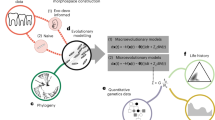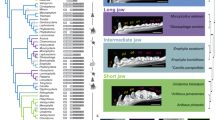Abstract
One motivation in the study of development is the discovery of mechanisms that may guide evolutionary change. Here we report how development governs relative size and number of cheek teeth, or molars, in the mouse. We constructed an inhibitory cascade model by experimentally uncovering the activator–inhibitor logic of sequential tooth development. The inhibitory cascade acts as a ratchet that determines molar size differences along the jaw, one effect being that the second molar always makes up one-third of total molar area. By using a macroevolutionary test, we demonstrate the success of the model in predicting dentition patterns found among murine rodent species with various diets, thereby providing an example of ecologically driven evolution along a developmentally favoured trajectory. In general, our work demonstrates how to construct and test developmental rules with evolutionary predictability in natural systems.
This is a preview of subscription content, access via your institution
Access options
Subscribe to this journal
Receive 51 print issues and online access
$199.00 per year
only $3.90 per issue
Buy this article
- Purchase on Springer Link
- Instant access to full article PDF
Prices may be subject to local taxes which are calculated during checkout





Similar content being viewed by others
References
Alberch, P. & Gale, E. A. A developmental analysis of an evolutionary trend: Digital reduction in amphibians. Evol. Int. J. Org. Evol. 39, 8–23 (1985)
Nijhout, H. F. & Emlen, D. J. Competition among body parts in the development and evolution of insect morphology. Proc. Natl Acad. Sci. USA 95, 3685–3689 (1998)
Wagner, G. P., Chiu, C.-H. & Laubichler, M. Developmental evolution as a mechanistic science: the inference from developmental mechanism to evolutionary processes. Am. Zool. 40, 819–831 (2000)
Salazar-Ciudad, I. & Jernvall, J. How different types of pattern formation mechanisms affect the evolution of form and development. Evol. Dev. 6, 6–16 (2004)
Emlen, D. J., Hunt, J. & Simmons, L. W. Evolution of sexual dimorphism and male dimorphism in the expression of beetle horns: phylogenetic evidence for modularity, evolutionary lability, and constraint. Am. Nat. 166, 42–68 (2005)
Polly, P. D. Development and phenotypic correlations: the evolution of tooth shape in Sorex araneus. Evol. Dev. 7, 29–41 (2005)
Brakefield, P. M. & Roskam, J. C. Exploring evolutionary constraints in a task for an integrative evolutionary biology. Am. Nat. 168, 4–13 (2006)
Colosimo, P. F. et al. Widespread parallel evolution in sticklebacks by repeated fixation of Ectodysplasin alleles. Science 307, 1928–1933 (2005)
Protas, M. E. et al. Genetic analysis of cavefish reveals molecular convergence in the evolution of albinism. Nature Genet. 38, 107–111 (2006)
Prud’homme, B. et al. Repeated morphological evolution through cis-regulatory changes in a pleiotropic gene. Nature 440, 1050–1053 (2006)
Shapiro, M. D., Bell, M. A. & Kingsley, D. M. Parallel genetic origins of pelvic reduction in vertebrates. Proc. Natl Acad. Sci. USA 103, 13753–13758 (2006)
True, J. & Haag, E. S. Developmental system drift and flexibility in evolutionary trajectories. Evol. Dev. 3, 109–119 (2001)
Abouheif, E. & Wray, G. A. Evolution of the gene network underlying wing polymorphism in ants. Science 297, 249–252 (2002)
Kawasaki, K., Suzuki, T. & Weiss, K. M. Phenogenetic drift in evolution: the changing genetic basis of vertebrate teeth. Proc. Natl Acad. Sci. USA 102, 18063–18068 (2005)
Tanaka, M. et al. Developmental genetic basis for the evolution of pelvic fin loss in the pufferfish Takifugu rubripes. Dev. Biol. 281, 227–239 (2005)
Bateson, W. Materials for the Study of Variation, Treated with Special Regard to Discontinuity in the Origin of Species (Macmillan, London, 1894)
Butler, P. M. Studies of the mammalian dentition. Differentiation of the post-canine dentition. Proc. Zool. Soc. London (B) 109, 1–36 (1939)
Kurtén, B. On the variation and population dynamics of fossil and recent mammal populations. Acta Zool. Fenn. 76, 1–122 (1953)
Van Valen, L. Growth fields in the dentition of Peromyscus. Evol. Int. J. Org. Evol. 16, 272–277 (1962)
Gould, S. J. & Garwood, R. A. Levels of integration in mammalian dentitions: an analysis of correlations in Nesophontes micrus (Insectivora) and Oryzomys couesi (Rodentia). Evol. Int. J. Org. Evol. 23, 276–300 (1969)
Sofaer, J. A., Bailit, H. L. & MacLean, C. J. A developmental basis for differential tooth reduction during Hominid evolution. Evol. Int. J. Org. Evol. 25, 509–517 (1971)
Osborn, J. W. in Development, Function and Evolution of Teeth (eds Butler, P. M. & Joysey, K. A.) 171–201 (Academic, London, 1978)
Smith, B. H. Dental development and the evolution of life-history in Hominidae. Am. J. Phys. Anthropol. 8, 157–174 (1991)
Godfrey, L. R., Samonds, K. E., Jungers, W. L. & Sutherland, M. R. in Primate Life Histories and Socioecology (eds Kappeler, P. M. & Pereira, M. E.) 177–203 (Univ. of Chicago Press, Chicago, 2003)
Boughner, J. C. & Dean, M. C. Does space in the jaw influence the timing of molar crown initiation? A model using baboons (Papio anubis) and great apes (Pan troglodytes, Pan paniscus). J. Hum. Evol. 46, 253–275 (2004)
Macchiarelli, R. et al. How Neanderthal molar teeth grew. Nature 444, 748–751 (2006)
Silvestri, A. R. & Singh, I. The unresolved problem of the third molar: Would people be better off without it? J. Am. Dent. Assoc. 134, 450–455 (2003)
Jernvall, J., Keränen, S. V. E. & Thesleff, I. Evolutionary modification of development in mammalian teeth: Quantifying gene expression patterns and topography. Proc. Natl Acad. Sci. USA 97, 14444–14448 (2000)
Salazar-Ciudad, I. & Jernvall, J. A gene network model accounting for development and evolution of mammalian teeth. Proc. Natl Acad. Sci. USA 99, 8116–8120 (2002)
Kassai, Y. et al. Regulation of mammalian tooth cusp patterning by Ectodin. Science 309, 2067–2070 (2005)
Gaunt, W. A. An analysis of the growth of the cheek teeth of the mouse. Acta Anat. 54, 220–259 (1963)
Gritli-Linde, A. et al. Shh signaling within the dental epithelium is necessary for cell proliferation, growth and polarization. Development 129, 5323–5337 (2002)
Harfe, B. D. et al. Evidence for an expansion-based temporal Shh gradient in specifying vertebrate digit identities. Cell 118, 517–528 (2004)
Sahlberg, C., Mustonen, T. & Thesleff, I. Explant cultures of embryonic epithelium: Analysis of mesenchymal signals. Methods Mol. Biol. 188, 373–382 (2002)
Åberg, T., Wozney, J. & Thesleff, I. Expression patterns of bone morphogenetic proteins (Bmps) in the developing mouse tooth suggest roles in morphogenesis and cell differentiation. Dev. Dyn. 210, 383–396 (1997)
Wang, X. P. et al. Modulation of activin/bone morphogenetic protein signaling by follistatin is required for the morphogenesis of mouse molar teeth. Dev. Dyn. 231, 98–108 (2004)
Klein, O. D. et al. Sprouty genes control diastema tooth development via bidirectional antagonism of epithelial–mesenchymal FGF signaling. Dev. Cell 11, 181–190 (2006)
Ferguson, C. A. et al. Activin is an essential early mesenchymal signal in tooth development that is required for patterning of the murine dentition. Genes Dev. 12, 2636–2649 (1998)
Jernvall, J., Åberg, T., Kettunen, P., Keränen, S. & Thesleff, I. The life history of an embryonic signaling center: BMP-4 induces p21 and is associated with apoptosis in the mouse tooth enamel knot. Development 125, 161–169 (1998)
Plikus, M. V. et al. Morphoregulation of teeth: modulating the number, size, shape and differentiation by tuning Bmp activity. Evol. Dev. 7, 440–457 (2005)
Jansa, S. A., Barker, F. K. & Heaney, L. R. The pattern and timing of diversification of Philippine endemic rodents: Evidence from mitochondrial and nuclear gene sequences. Syst. Biol. 55, 73–88 (2006)
Evans, A. R., Wilson, G. P., Fortelius, M. & Jernvall, J. High-level similarity of dentitions in carnivorans and rodents. Nature 445, 78–81 (2007)
Garn, S. M., Lewis, A. B. & Kerewsky, R. S. Third molar agenesis and size reduction of the remaining teeth. Nature 200, 488–489 (1963)
Polly, P. D. Variability in mammalian dentitions: size-related bias in the coefficient of variation. Biol. J. Linn. Soc. 64, 83–99 (1998)
Lucas, P. W., Corlett, R. T. & Luke, D. A. Sexual dimorphism of tooth size in anthropoids. Hum. Evol. 1, 23–29 (1986)
Guthrie, R. D. Variability in characters undergoing rapid evolution, an analysis of Microtus molars. Evol. Int. J. Org. Evol. 19, 214–233 (1965)
Kangas, A. T., Evans, A. R., Thesleff, I. & Jernvall, J. Nonindependence of mammalian dental characters. Nature 432, 211–214 (2004)
Kist, R. et al. Reduction of Pax9 gene dosage in an allelic series of mouse mutants causes hypodontia and oligodontia. Hum. Mol. Genet. 14, 3605–3617 (2005)
Sokal, R. R. & Rohlf, F. J. Biometry (Freeman, New York, 1995)
Harrington, A. E. et al. Structural basis for the inhibition of activin signalling by follistatin. EMBO J. 25, 1035–1045 (2006)
Acknowledgements
We thank C. K. Chapple, G. Evans, M. Fortelius, I. Salazar-Ciudad, M. Mikkola, I. Thesleff, G. P. Wilson and P. C. Wright for comments, discussions and support with this work; P. Munne, M. Mäkinen, E. Penttilä, I. Pljusnin, R. Santalahti and R. Savolainen for technical help; M. Hyvönen for activin A recombinant protein; C. Tabin and A. Gritli-Linde for the ShhGFPCre mice; and the following museum curators and collection managers for loans: O. Grönwall, R. Asher, M. Hildén and I. Hanski. This study was supported by the Academy of Finland.
Author Contributions K.D.K. and J.J. conceived the study; K.D.K. performed developmental experiments; A.R.E. acquired three-dimensional data; K.D.K., A.R.E. and J.J. performed quantitative analyses; A.R.E. and J.J. constructed the model; A.R.E. performed computer simulations; K.D.K., A.R.E. and J.J. wrote the paper; and J.J. coordinated the study.
The three-dimensional scans for this study are deposited in the MorphoBrowser database, at http://morphobrowser.biocenter.helsinki.fi/.
Author information
Authors and Affiliations
Corresponding authors
Ethics declarations
Competing interests
Reprints and permissions information is available at www.nature.com/reprints. The authors declare no competing financial interests.
Supplementary information
Supplementary Information
The file contains Supplementary Figures 1-2 and Legends; Supplementary Tables 1-7 The Supplementary Figures show places of dissection separating M1 from the tails forming posterior molars and growth curves of cultured teeth. The Supplementary Tables list data for the experimental and macroevolutionary analyses and the full results of statistical tests mentioned in the paper. (PDF 980 kb)
Rights and permissions
About this article
Cite this article
Kavanagh, K., Evans, A. & Jernvall, J. Predicting evolutionary patterns of mammalian teeth from development. Nature 449, 427–432 (2007). https://doi.org/10.1038/nature06153
Received:
Accepted:
Issue Date:
DOI: https://doi.org/10.1038/nature06153
This article is cited by
-
Stability in gene expression and body-plan development leads to evolutionary conservation
EvoDevo (2023)
-
Rules of teeth development align microevolution with macroevolution in extant and extinct primates
Nature Ecology & Evolution (2023)
-
Bat teeth illuminate the diversification of mammalian tooth classes
Nature Communications (2023)
-
The Notch-mediated circuitry in the evolution and generation of new cell lineages: the tooth model
Cellular and Molecular Life Sciences (2023)
-
Stripe and spot selection in cusp patterning of mammalian molar formation
Scientific Reports (2022)
Comments
By submitting a comment you agree to abide by our Terms and Community Guidelines. If you find something abusive or that does not comply with our terms or guidelines please flag it as inappropriate.



